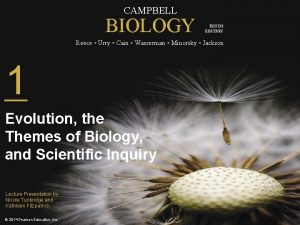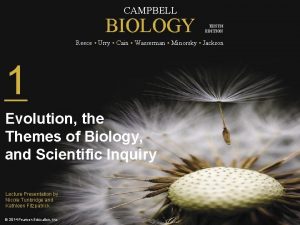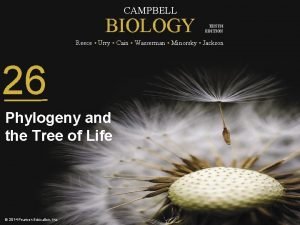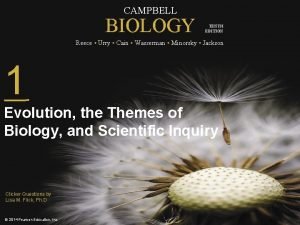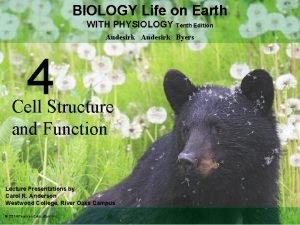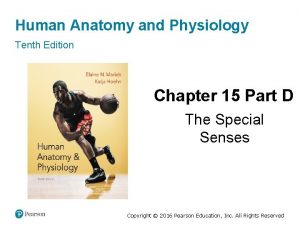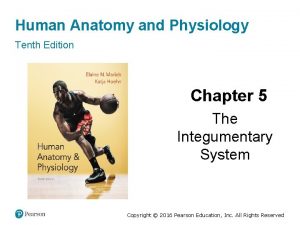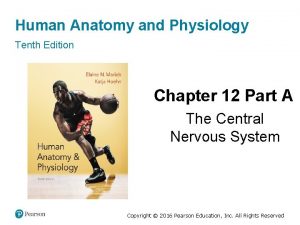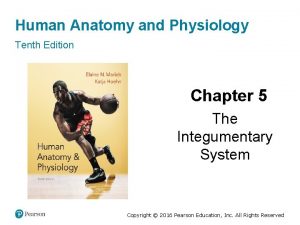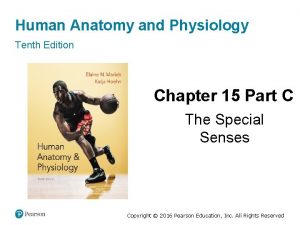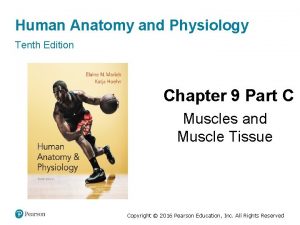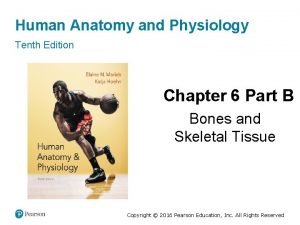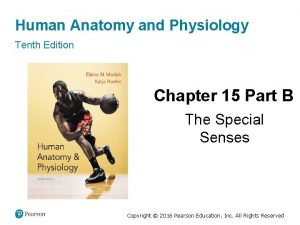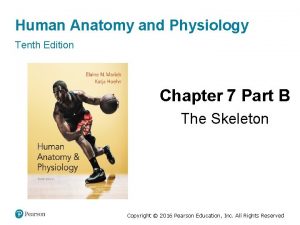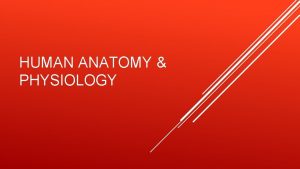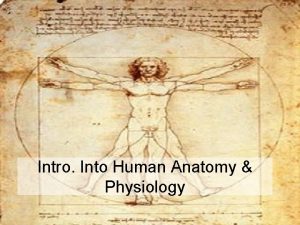Human Anatomy and Physiology Tenth Edition Chapter 6



















































- Slides: 51

Human Anatomy and Physiology Tenth Edition Chapter 6 Part A Bones and Skeletal Tissue Copyright © 2016 Pearson Education, Inc. All Rights Reserved

6. 1 Skeletal Cartilages • The human skeleton initially consists of just cartilage, which is replaced by bone, except in areas requiring flexibility Copyright © 2016 Pearson Education, Inc. All Rights Reserved

Basic Structure, Types, and Locations (1 of 2) • Skeletal cartilage: made of highly resilient, molded cartilage tissue that consists primarily of water – Contains no blood vessels or nerves • Perichondrium: layer of dense connective tissue surrounding cartilage like a girdle – Helps cartilage resist outward expansion – Contains blood vessels for nutrient delivery to cartilage • Cartilage is made up of chondrocytes, cells encased in small cavities (lacunae) within jelly-like extracellular matrix Copyright © 2016 Pearson Education, Inc. All Rights Reserved

Copyright © 2016 Pearson Education, Inc. All Rights Reserved

Basic Structure, Types, and Locations (2 of 2) • Three types of cartilage: – Hyaline cartilage § Provides support, flexibility, and resilience § Most abundant type; contains collagen fibers only § Articular (joints), costal (ribs), respiratory (larynx), nasal cartilage (nose tip) – Elastic cartilage § Similar to hyaline cartilage, but contains elastic fibers § External ear and epiglottis – Fibrocartilage § Thick collagen fibers: has great tensile strength § Menisci of knee; vertebral discs Copyright © 2016 Pearson Education, Inc. All Rights Reserved

Copyright © 2016 Pearson Education, Inc. All Rights Reserved

Copyright © 2016 Pearson Education, Inc. All Rights Reserved

Figure 6. 1 The Bones and Cartilages of the Human Skeleton (1 of 2) Copyright © 2016 Pearson Education, Inc. All Rights Reserved

Growth of Cartilage • Cartilage grows in two ways: – Appositional growth § Cartilage-forming cells in perichondrium secrete matrix against external face of existing cartilage – New matrix laid down on surface of cartilage – Interstitial growth § Chondrocytes within lacunae divide and secrete new matrix, expanding cartilage from within – New matrix made within cartilage Copyright © 2016 Pearson Education, Inc. All Rights Reserved

6. 2 Functions of Bones (1 of 2) • There are seven important functions of bones: 1. Support § For body and soft organs 2. Protection § Protect brain, spinal cord, and vital organs 3. Movement § Levers for muscle action 4. Mineral and growth factor storage § Calcium and phosphorus, and growth factors reservoir Copyright © 2016 Pearson Education, Inc. All Rights Reserved

6. 2 Functions of Bones (2 of 2) 5. Blood cell formation § Hematopoiesis occurs in red marrow cavities of certain bones 6. Triglyceride (fat) storage § Fat, used for an energy source, is stored in bone cavities 7. Hormone production § Osteocalcin secreted by bones helps to regulate insulin secretion, glucose levels, and metabolism Copyright © 2016 Pearson Education, Inc. All Rights Reserved

6. 3 Classification of Bones (1 of 3) • 206 named bones in human skeleton • Divided into two groups based on location – Axial skeleton § Long axis of body § Skull, vertebral column, rib cage – Appendicular skeleton § Bones of upper and lower limbs § Girdles attaching limbs to axial skeleton Copyright © 2016 Pearson Education, Inc. All Rights Reserved

Figure 6. 1 The Bones and Cartilages of the Human Skeleton (2 of 2) Copyright © 2016 Pearson Education, Inc. All Rights Reserved

6. 3 Classification of Bones (2 of 3) • Bones are also classified according to one of four shapes: 1. Long bones § Longer than they are wide § Limb bones 2. Short bones § Cube-shaped bones (in wrist and ankle) § Sesamoid bones form within tendons (example: patella) § Vary in size and number in different individuals Copyright © 2016 Pearson Education, Inc. All Rights Reserved

6. 3 Classification of Bones (3 of 3) 3. Flat bones § Thin, flat, slightly curved § Sternum, scapulae, ribs, most skull bones 4. Irregular bones § Complicated shapes § Vertebrae and hip bones Copyright © 2016 Pearson Education, Inc. All Rights Reserved

Figure 6. 2 Classification of Bones on the Basis of Shape Copyright © 2016 Pearson Education, Inc. All Rights Reserved

6. 4 Bone Structure • Bones are organs because they contain different types of tissues – Bone (osseous) tissue predominates, but a bone also has nervous tissue, cartilage, fibrous connective tissue, muscle cells, and epithelial cells in its blood vessels • Three levels of structure – Gross – Microscopic – Chemical Copyright © 2016 Pearson Education, Inc. All Rights Reserved

Gross Anatomy • Compact and spongy bone – Compact bone: dense outer layer on every bone that appears smooth and solid – Spongy bone: made up of a honeycomb of small, needle-like or flat pieces of bone called trabeculae § Open spaces between trabeculae are filled with red or yellow bone marrow Copyright © 2016 Pearson Education, Inc. All Rights Reserved

Gross Anatomy • Structure of short, irregular, and flat bones – Consist of thin plates of spongy bone (diploe) covered by compact bone – Compact bone sandwiched between connective tissue membranes § Periosteum covers outside of compact bone, and endosteum covers inside portion of compact bone – Bone marrow is scattered throughout spongy bone; no defined marrow cavity – Hyaline cartilage covers area of bone that is part of a movable joint Copyright © 2016 Pearson Education, Inc. All Rights Reserved

Figure 6. 3 Flat Bones Consist of a Layer of Spongy Bone Sandwiched Between Two Thin Layers of Compact Bone (1 of 2) Copyright © 2016 Pearson Education, Inc. All Rights Reserved

Gross Anatomy • Structure of typical long bone – All long bones have a shaft (diaphysis), bone ends (epiphyses), and membranes § Diaphysis: tubular shaft that forms long axis of bone – Consists of compact bone surrounding central medullary cavity that is filled with yellow marrow in adults § Epiphyses: ends of long bones that consist of compact bone externally and spongy bone internally – Articular cartilage covers articular (joint) surfaces § Between diaphysis and epiphysis is epiphyseal line – Remnant of childhood epiphyseal plate where bone growth occurs Copyright © 2016 Pearson Education, Inc. All Rights Reserved

Figure 6. 4 a The Structure of a Long Bone (Humerus of Arm) Copyright © 2016 Pearson Education, Inc. All Rights Reserved

Figure 6. 4 b The Structure of a Long Bone (Humerus of Arm) Copyright © 2016 Pearson Education, Inc. All Rights Reserved

Gross Anatomy • Membranes: two types (periosteum and endosteum) – Periosteum: white, double-layered membrane that covers external surfaces except joints – Endosteum § Delicate connective tissue membrane covering internal bone surface § Covers trabeculae of spongy bone § Lines canals that pass through compact bone § Like periosteum, contains osteogenic cells that can differentiate into other bone cells Copyright © 2016 Pearson Education, Inc. All Rights Reserved

Figure 6. 4 c The Structure of a Long Bone (Humerus of Arm) Copyright © 2016 Pearson Education, Inc. All Rights Reserved

Gross Anatomy • Hematopoietic tissue in bones – Red marrow is found within trabecular cavities of spongy bone and diploë of flat bones, such as sternum § In newborns, medullary cavities and all spongy bone contain red marrow § In adults, red marrow is located in heads of femur and humerus, but most active areas of hematopoiesis are flat bone diploë and some irregular bones (such as the hip bone) § Yellow marrow can convert to red, if person becomes anemic Copyright © 2016 Pearson Education, Inc. All Rights Reserved

Gross Anatomy • Bone markings – Sites of muscle, ligament, and tendon attachment on external surfaces – Areas involved in joint formation or conduits for blood vessels and nerves Copyright © 2016 Pearson Education, Inc. All Rights Reserved

Gross Anatomy • Bone markings – Three types of markings: § Projection: outward bulge of bone – May be due to increased stress from muscle pull or is a modification for joints § Depression: bowl- or groove-like cut-out that can serve as passageways for vessels and nerves, or plays a role in joints § Opening: hole or canal in bone that serves as passageways for blood vessels and nerves Copyright © 2016 Pearson Education, Inc. All Rights Reserved

Table 6. 1 Bone Markings Name of Bone Marking Description Illustrations Projections That Are Sites of Muscle and Ligament Attachment Blank Tuberosity (too”bě-ros’ĭ-te) Large rounded projection; may be Roughened Crest Narrow ridge of bone; usually Trochanter (tro-kan′ter) prominent Very large, blunt, irregularly shaped process (the only examples are on the femur) Line Narrow ridge of bone; less prominent than a crest Tubercle (too′ber-kl) Small rounded projection or process Epicondyle (ep”ĭ-kon’dīl) Raised area on or above a condyle Spine Sharp, slender, often pointed projection The hip bone, femur of the thigh, and the vertebra have different bone markings. On the hip bone, the iliac crest is an arc-shaped ridge at the superior end. The ischial spine is a rounded, cone-shape bump projecting posteriorly from the middle hip, and the ischial tuberosity is a bumpy ridge of increased thickness extending along the inferior edge of the posterior hip. In the femur, the trochanters are irregular, enlarged regions at the superior end of the bone, and the intertrochanteric line is a narrow ridge extending from one trochanter along the base of the ball joint to the other trochanter. The condyle is an enlarged region at the inferior end of the bone with medial and lateral lobes. The medial epicondyle is a ridge along the super side of the condyle’s medial lobe, and the adductor tubercle is a small bump extending medially from the medial epicondyle. In the vertebra, the spinous process is a flat, vertically oriented band of bone extending from the main segment of the vertebra in the posterior and inferior directions. Process Any bony prominence Copyright © 2016 Pearson Education, Inc. All Rights Reserved

Table 6. 1 Bone Markings Name of Bone Marking Description Illustrations Projections That Help to Form Joints Blank Head Bony expansion carried on a narrow neck The rib and mandible have different bone markings. The posterior end of the rib narrows in the posterior direction, before broadening into an enlarged region called the head. The head has flat connecting surfaces called facets. In the mandible, the condyle is a knob that extends medially from the superior left and right ends of the mandible. The ramus is a bar of bone extending in the anterior and inferior directions from the condyle to the lower mandible, in which the teeth are set. Facet Condyle (kon′dīl) Smooth, nearly flat articular surface Rounded articular projection Ramus (ra′mus) Armlike bar of bone Copyright © 2016 Pearson Education, Inc. All Rights Reserved

Table 6. 1 Bone Markings Name of Bone Marking Description Illustrations Depressions and Openings Blank For Passage of Blood Vessels and Nerves Blank Groove Furrow Fissure Narrow, slitlike opening Foramen (fo-ra′men) Round or oval opening through a bone The skull has different bone markings. A groove runs along the mandible midway between the gum and inferior edge. The superior lateral end of the mandible sits in a notch of the skull. The fossa and meatus mark the inferior medial and posterior skull. The inferior orbital fissure opens in the posterior wall of the orbital cavity, and the foramen is below the inferior anterior edge of the orbital cavity. Notch Indentation at the edge of a structure Others Meatus (me-a′tus) Canal-like passageway Sinus Cavity within a bone, filled with air and lined with mucous membrane Fossa (fos′ah) Shallow, basinlike depression in a bone, often serving as an articular surface Copyright © 2016 Pearson Education, Inc. All Rights Reserved

Microscopic Anatomy of Bone (1 of 12) • Cells of bone tissue – Five major cell types, each of which is a specialized form of the same basic cell type 1. 2. 3. 4. 5. Osteogenic cells Osteoblasts Osteocytes Bone-lining cells Osteoclasts Copyright © 2016 Pearson Education, Inc. All Rights Reserved

Microscopic Anatomy of Bone (2 of 12) 1. Osteogenic cells – Also called osteoprogenitor cells – Mitotically active stem cells in periosteum and endosteum – When stimulated, they differentiate into osteoblasts or bone-lining cells – Some remain as osteogenic stem cells Copyright © 2016 Pearson Education, Inc. All Rights Reserved

Microscopic Anatomy of Bone (3 of 12) 2. Osteoblasts – Bone-forming cells that secrete unmineralized bone matrix called osteoid § Osteoid is made up of collagen and calcium-binding proteins § Collagen makes up 90% of bone protein – Osteoblasts are actively mitotic Copyright © 2016 Pearson Education, Inc. All Rights Reserved

Figure 6. 5 ab Comparison of Different Types of Bone Cells Copyright © 2016 Pearson Education, Inc. All Rights Reserved

Microscopic Anatomy of Bone (4 of 12) 3. Osteocytes – Mature bone cells in lacunae that no longer divide – Maintain bone matrix and act as stress or strain sensors § Respond to mechanical stimuli such as increased force on bone or weightlessness § Communicate information to osteoblasts and osteoclasts (cells that destroy bone) so bone remodeling can occur Copyright © 2016 Pearson Education, Inc. All Rights Reserved

Microscopic Anatomy of Bone (5 of 12) 4. Bone-lining cells – Flat cells on bone surfaces believed to also help maintain matrix (along with osteocytes) – On external bone surface, lining cells are called periosteal cells – On internal surfaces, they are called endosteal cells Copyright © 2016 Pearson Education, Inc. All Rights Reserved

Microscopic Anatomy of Bone (6 of 12) 5. Osteoclasts – Derived from same hematopoietic stem cells that become macrophages – Giant, multinucleate cells function in bone resorption (breakdown of bone) – When active, cells are located in depressions called resorption bays – Cells have ruffled borders that serve to increase surface area for enzyme degradation of bone § Also helps seal off area from surrounding matrix Copyright © 2016 Pearson Education, Inc. All Rights Reserved

Figure 6. 5 cd Comparison of Different Types of Bone Cells Copyright © 2016 Pearson Education, Inc. All Rights Reserved

Microscopic Anatomy of Bone (7 of 12) • Compact bone – Also called lamellar bone – Consists of: § Osteon (Haversian system) § Canals and canaliculi § Interstitial and circumferential lamellae Copyright © 2016 Pearson Education, Inc. All Rights Reserved

Microscopic Anatomy of Bone (8 of 12) • Osteon (Haversian system) – An osteon is the structural unit of compact bone – Consists of an elongated cylinder that runs parallel to long axis of bone § Acts as tiny weight-bearing pillars – An osteon cylinder consists of several rings of bone matrix called lamellae § Lamellae contain collagen fibers that run in different directions in adjacent rings § Withstands stress and resist twisting § Bone salts are found between collagen fibers Copyright © 2016 Pearson Education, Inc. All Rights Reserved

Figure 6. 6 A Single Osteon Copyright © 2016 Pearson Education, Inc. All Rights Reserved

Microscopic Anatomy of Bone (9 of 12) • Canals and canaliculi – Central (Haversian) canal runs through core of osteon § Contains blood vessels and nerve fibers – Perforating (Volkmann’s) canals: canals lined with endosteum that occur at right angles to central canal § Connect blood vessels and nerves of periosteum, medullary cavity, and central canal Copyright © 2016 Pearson Education, Inc. All Rights Reserved

Microscopic Anatomy of Bone (10 of 12) • Canals and canaliculi – Lacunae: small cavities that contain osteocytes – Canaliculi: hairlike canals that connect lacunae to each other and to central canal – Osteoblasts that secrete bone matrix maintain contact with each other and osteocytes via cell projections with gap junctions – When matrix hardens and cells are trapped the canaliculi form § Allow communication between all osteocytes of osteon and permit nutrients and wastes to be relayed from one cell to another Copyright © 2016 Pearson Education, Inc. All Rights Reserved

Microscopic Anatomy of Bone (11 of 12) • Interstitial and circumferential lamellae – Interstitial lamellae § Lamellae that are not part of osteon § Some fill gaps between forming osteons; others are remnants of osteons cut by bone remodeling – Circumferential lamellae § Just deep to periosteum, but superficial to endosteum, these layers of lamellae extend around entire surface of diaphysis § Help long bone to resist twisting Copyright © 2016 Pearson Education, Inc. All Rights Reserved

Figure 6. 7 Microscopic Anatomy of Compact Bone Copyright © 2016 Pearson Education, Inc. All Rights Reserved

Microscopic Anatomy of Bone (12 of 12) • Spongy bone – Appears poorly organized but is actually organized along lines of stress to help bone resist any stress – Trabeculae, like cables on a suspension bridge, confer strength to bone § No osteons are present, but trabeculae do contain irregularly arranged lamellae and osteocytes interconnected by canaliculi § Capillaries in endosteum supply nutrients Copyright © 2016 Pearson Education, Inc. All Rights Reserved

Figure 6. 3 Flat Bones Consist of a Layer of Spongy Bone Sandwiched Between Two Thin Layers of Compact Bone (2 of 2) Copyright © 2016 Pearson Education, Inc. All Rights Reserved

Chemical Composition of Bone (1 of 3) • Bone is made up of both organic and inorganic components – Organic components § Includes osteogenic cells, osteoblasts, osteocytes, bonelining cells, osteoclasts, and osteoid – Osteoid, which makes up one-third of organic bone matrix, is secreted by osteoblasts • Consists of ground substance and collagen fibers, which contribute to high tensile strength and flexibility of bone Copyright © 2016 Pearson Education, Inc. All Rights Reserved

Chemical Composition of Bone (2 of 3) • Organic components – Resilience of bone is due to sacrificial bonds in or between collagen molecules that stretch and break to dissipate energy and prevent fractures – If no additional trauma, bonds re-form • Inorganic components – Hydroxyapatites (mineral salts) § Makeup 65% of bone by mass § Consist mainly of tiny calcium phosphate crystals in and around collagen fibers § Responsible for hardness and resistance to compression Copyright © 2016 Pearson Education, Inc. All Rights Reserved

Chemical Composition of Bone (3 of 3) • Inorganic components – Bone is half as strong as steel in resisting compression and as strong as steel in resisting tension – Lasts long after death because of mineral composition – Can reveal information about ancient people Copyright © 2016 Pearson Education, Inc. All Rights Reserved
 Human anatomy and physiology seventh edition marieb
Human anatomy and physiology seventh edition marieb Paratubular cyst
Paratubular cyst Human anatomy & physiology edition 9
Human anatomy & physiology edition 9 Chapter 1 introduction to human anatomy and physiology
Chapter 1 introduction to human anatomy and physiology Medial lateral distal proximal
Medial lateral distal proximal Chapter 2 human reproductive anatomy and physiology
Chapter 2 human reproductive anatomy and physiology Holes essential of human anatomy and physiology
Holes essential of human anatomy and physiology Campbell biology tenth edition
Campbell biology tenth edition Campbell biology tenth edition
Campbell biology tenth edition Campbell biology tenth edition
Campbell biology tenth edition Elementary statistics tenth edition
Elementary statistics tenth edition Digital electronics by floyd
Digital electronics by floyd Corporate finance tenth edition
Corporate finance tenth edition Psychology tenth edition david g myers
Psychology tenth edition david g myers Human genetics concepts and applications 10th edition
Human genetics concepts and applications 10th edition Corporate finance tenth edition
Corporate finance tenth edition Corporate finance tenth edition
Corporate finance tenth edition Corporate finance tenth edition
Corporate finance tenth edition Corporate finance tenth edition
Corporate finance tenth edition Campbell biology tenth edition
Campbell biology tenth edition The graph shows data from the light colored soil
The graph shows data from the light colored soil Cloroplastos
Cloroplastos Biology tenth edition
Biology tenth edition Chapter 14 anatomy and physiology
Chapter 14 anatomy and physiology Anatomy and physiology chapter 8 special senses
Anatomy and physiology chapter 8 special senses Chapter 13 anatomy and physiology of pregnancy
Chapter 13 anatomy and physiology of pregnancy Anatomy and physiology chapter 2
Anatomy and physiology chapter 2 Chapter 7 anatomy and physiology
Chapter 7 anatomy and physiology Anatomy and physiology coloring workbook chapter 14
Anatomy and physiology coloring workbook chapter 14 Chapter 10 blood anatomy and physiology
Chapter 10 blood anatomy and physiology Anatomy and physiology chapter 15
Anatomy and physiology chapter 15 Necessary life functions anatomy and physiology
Necessary life functions anatomy and physiology Holes anatomy and physiology chapter 1
Holes anatomy and physiology chapter 1 Anatomy and physiology chapter 15
Anatomy and physiology chapter 15 Male vs female skeleton pelvis
Male vs female skeleton pelvis Chapter 6 general anatomy and physiology
Chapter 6 general anatomy and physiology Olecranal region
Olecranal region Human anatomy fifth edition
Human anatomy fifth edition Human anatomy fifth edition
Human anatomy fifth edition Physiology of sport and exercise 5th edition
Physiology of sport and exercise 5th edition Parts of the upper respiratory tract
Parts of the upper respiratory tract Tattoo anatomy and physiology
Tattoo anatomy and physiology Science olympiad anatomy and physiology
Science olympiad anatomy and physiology Incomplete flower
Incomplete flower Bone anatomy and physiology
Bone anatomy and physiology Stomach ulcer
Stomach ulcer Liver anatomy and physiology
Liver anatomy and physiology Epigastric region
Epigastric region Difference between anatomy and physiology
Difference between anatomy and physiology Google.com
Google.com Http://anatomy and physiology
Http://anatomy and physiology Anatomy and physiology of appendicitis
Anatomy and physiology of appendicitis








